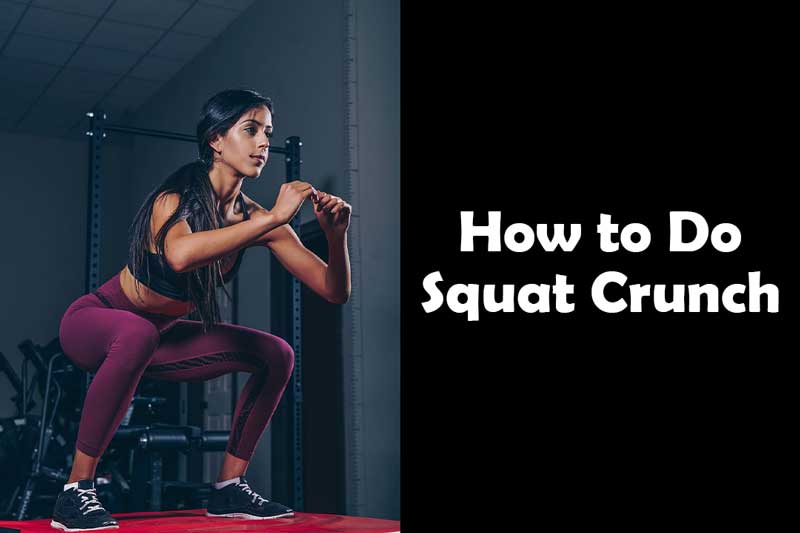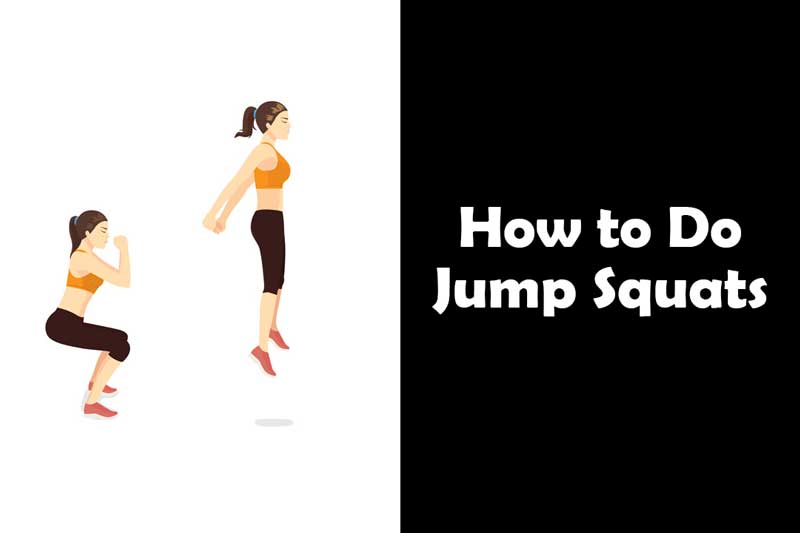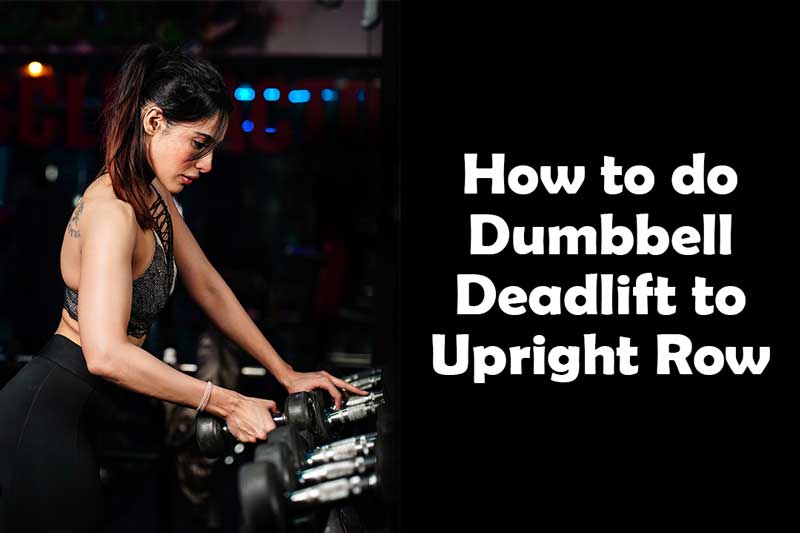Looking for an effective exercise that targets your whole body, especially abdominal muscles while also engaging your lower body? There is nothing better than the squat crunch.
In this comprehensive guide, we will walk you through the steps of performing a squat crunch with proper form and technique. Whether you’re a beginner or an experienced fitness enthusiast, this exercise can help you strengthen your core and enhance overall body stability.
So, let’s dive in and learn how to do a squat crunch correctly.
Understanding the Benefits of Squat Crunch
The squat crunch is a compound exercise that combines the movements of a squat and a crunch to engage multiple muscle groups simultaneously. It primarily targets the abdominal muscles, including the rectus abdominis, obliques, and transverse abdominis.
Additionally, it involves the quadriceps, hamstrings, glutes, and lower back muscles, making it a highly efficient full-body exercise.
Performing squat crunches regularly can provide several benefits, such as:
1) Core Strength and Stability
One of the primary benefits of squat crunches is the development of core strength and stability. The exercise targets the abdominal muscles, including the rectus abdominis, obliques, and transverse abdominis.
By engaging and strengthening these muscles, squat crunches help improve posture, enhance spinal stability, and provide a solid foundation for other movements and activities.
2) Abdominal Definition
Squat crunches can contribute to achieving a toned and defined midsection. As the abdominal muscles are repeatedly contracted and engaged during the exercise, they become stronger and more visible over time.
Combined with a balanced diet and overall body fat reduction, squat crunches can help create a more sculpted and chiseled appearance in the abdominal area.
3) Hip and Leg Strength
The squat phase of the exercise involves the glutes, quadriceps, and hamstrings. These muscles are responsible for hip extension, knee extension, and knee flexion, respectively.
By consistently performing squat crunches, these muscle groups are targeted and strengthened, leading to improved hip and leg strength. This can enhance athletic performance, increase overall power, and support functional movements in daily life.
4) Improved Posture and Spinal Stability
Squat crunches require maintaining proper posture throughout the exercise, including a straight back and aligned spine. By practicing good form and engaging the core muscles, squat crunches help improve postural alignment and spinal stability.
This can alleviate back pain, reduce the risk of injury, and promote overall spinal health and well-being.
5) Functional Fitness
Squat crunches are a compound exercise that mimics movements used in daily activities. By combining the squat and crunch motions, the exercise improves functional fitness by enhancing coordination, balance, and overall body control.
These benefits can translate into improved performance in activities such as lifting objects, bending down, and maintaining stability during various movements.
6) Calorie Burning and Weight Management
Squat crunches engage multiple muscle groups simultaneously, resulting in an increased calorie burn during the exercise. This can contribute to weight management and calorie expenditure.
Additionally, as squat crunches help build lean muscle mass, they can elevate metabolism and promote fat burning even at rest.
7) Variety and Progression
Squat crunches offer versatility and room for progression. The exercise can be modified to suit different fitness levels and goals. Beginners can start with bodyweight squat crunches and gradually increase repetitions and intensity.
Advanced individuals can incorporate variations such as weighted squat crunches or stability ball squat crunches to further challenge the muscles and add variety to their workout routine.
8) Core Integration
Squat crunches promote the integration of the entire core musculature. By engaging the abdominal muscles, lower back muscles, and stabilizing muscles, such as the glutes and hip muscles, squat crunches encourage coordinated and efficient muscle activation.
This improves overall core function and enhances performance in other exercises and physical activities.
Muscles Worked during Squat Crunch
During a squat crunch, multiple muscle groups are engaged, including the abdominal muscles, lower back muscles, glutes, quadriceps, and hamstrings. Let’s explore each of these muscles and their specific roles in the exercise:
1) Abdominal Muscles:
- Rectus Abdominis: The rectus abdominis, commonly known as the “six-pack” muscles, runs vertically down the front of the abdomen. It contracts during the crunch phase of the squat crunch, flexing the spine and bringing the ribcage closer to the pelvis.
- Obliques: The obliques are located on the sides of the abdomen, and they play a crucial role in rotational movements. During the squat crunch, they assist in bending the torso laterally and contribute to the overall stability of the exercise.
- Transverse Abdominis: The transverse abdominis is a deep muscle that wraps around the abdomen like a corset. It acts as a stabilizer, providing support to the spine and maintaining proper posture during the squat crunch.
2) Lower Back Muscles:
- Erector Spinae: The erector spinae muscles run along the length of the spine and help maintain an upright posture. During the squat crunch, they work isometrically to stabilize the spine and prevent excessive flexion or extension.
3) Glutes:
- Gluteus Maximus: As the largest muscle in the body, the gluteus maximus plays a significant role in hip extension. During the squat phase of the exercise, it contracts to push the hips back and maintain balance and stability.
- Gluteus Medius and Gluteus Minimus: These muscles, situated on the sides of the hips, assist in hip abduction and rotation. They contribute to overall hip stability during the squat crunch.
4) Quadriceps:
- Rectus Femoris, Vastus Lateralis, Vastus Medialis, and Vastus Intermedius: Collectively known as the quadriceps, these muscles are located on the front of the thigh. They are responsible for extending the knee joint during the squat phase of the exercise, aiding in the upward movement.
5) Hamstrings:
- Biceps Femoris, Semitendinosus, and Semimembranosus: Pretty hard to pronounce but these muscles make up the hamstrings, situated on the back of the thigh. During the squat crunch, they act as stabilizers and help control the descent by eccentrically contracting to control knee flexion.
Preparing for Squat Crunch
Before you start performing squat crunches, it’s important to prepare yourself adequately. Here are a few steps to follow:
- Find a suitable workout space: Choose an area with enough room for you to move comfortably. Make sure the surface is level and provides ample support.
- Wear appropriate workout attire: Opt for comfortable clothing that allows freedom of movement. It’s also advisable to wear athletic shoes that provide stability and cushioning.
- Warm up: Perform a brief warm-up routine consisting of dynamic stretches and light cardio exercises to increase blood flow to the muscles and prepare them for the workout ahead.
- Consult a healthcare professional: If you have any existing medical conditions or concerns, it’s always a good idea to consult with a healthcare professional before starting a new exercise regimen.
Now that you’re ready, let’s move on to the step-by-step guide on how to perform a squat crunch.
Step-by-Step Guide: How to Perform Squat Crunch
1) Starting Position
To begin the squat crunch, follow these steps:
- Stand with your feet shoulder-width apart, toes pointing slightly outward.
- Keep your back straight, shoulders relaxed, and chest lifted.
- Engage your core by pulling your belly button in towards your spine.
- Extend your arms forward for balance or place your hands behind your head, lightly supporting it with your fingers.
2) Squat Position
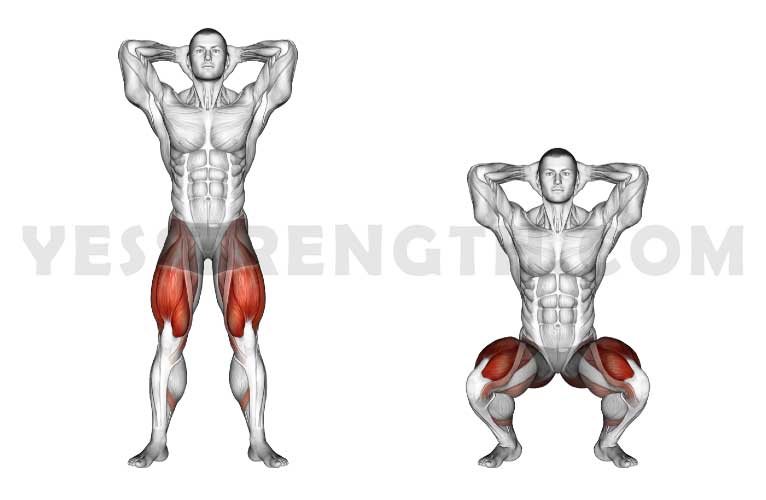
Next, transition into the squat position:
- Lower your body by bending your knees and pushing your hips back as if you were sitting into a chair.
- Keep your weight in your heels and maintain a neutral spine alignment.
- Squat down until your thighs are parallel to the floor or as far as your flexibility allows.
- Pause for a brief moment at the bottom of the squat.
3) Crunch Position
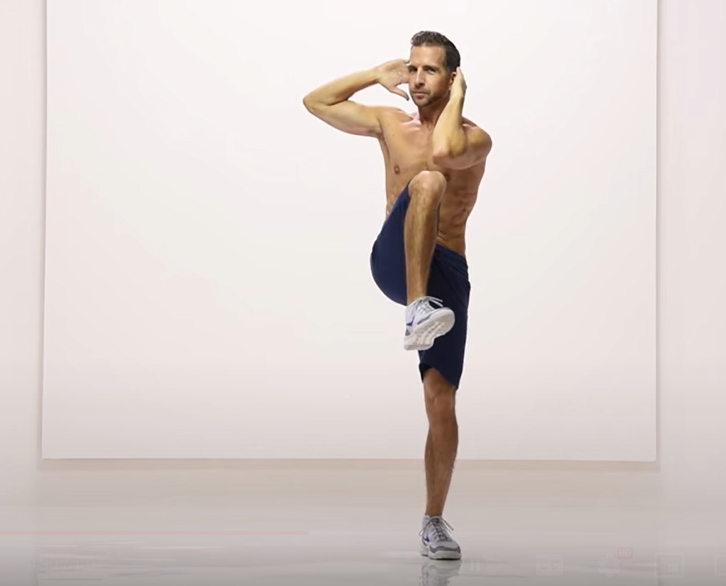
Now, it’s time to move into the crunch position:
- From the squat position, engage your core and exhale as you lift your left knee towards your chest.
- Simultaneously, bring your right arm forward (while keeping your hands behind your head, curling your torso.
- Contract your abdominal muscles as you perform the crunch, focusing on the squeeze in your abs.
- Now bring them back to the initial position and repeat the same process but with the right knee (leg) and left arm.
- Maintain control and avoid using momentum to swing your body.
Now Repeat this for as many repetitions as you want.
You might also like:
Common Mistakes to Avoid
While performing squat crunches, it’s important to maintain proper form and technique to maximize the effectiveness of the exercise and prevent injuries. Here are some common mistakes to avoid:
1) Arching the Back
Arching the back excessively during the squat or crunch phases can put excessive strain on the spine and lead to lower back discomfort. Focus on maintaining a neutral spine alignment throughout the exercise.
2) Using Momentum
Avoid relying on momentum to swing your body during the movement. Instead, engage your core muscles and perform the squat crunch with controlled and deliberate motions.
3) Neglecting Proper Breathing Technique
Remember to breathe correctly during each phase of the exercise. Exhale as you crunch and inhale as you return to the starting position. Proper breathing helps stabilize your core and enhances overall performance.
Variations of Squat Crunch
To add variety and challenge to your workout routine, you can try the following variations of the squat crunch:
1) Weighted Squat Crunch
Hold a dumbbell or kettlebell close to your chest during the exercise to increase resistance and further engage your core muscles.
2) Stability Ball Squat Crunch
Perform the squat crunch on a stability ball instead of the floor. This variation adds an element of instability, requiring more core strength and balance.
3) Side-to-Side Squat Crunch
Instead of performing a regular squat crunch, alternate between lifting your knees towards each side, targeting the oblique muscles and adding a rotational component to the exercise. It should feel like you’re kicking something with your knees but on the sides, opening your legs towards the sides.
Tips for Maximizing the Effectiveness of Squat Crunch
Here are some additional tips to help you get the most out of your squat crunch workout:
- Gradually increase the difficulty: Start with bodyweight squat crunches and gradually progress to weighted variations as your strength and technique improve.
- Focus on the mind-muscle connection: Visualize and concentrate on the targeted muscles throughout each repetition to maximize muscle activation.
- Incorporate it into your routine: Include squat crunches as part of a well-rounded workout program that includes cardio, strength training, and flexibility exercises.
- Maintain a consistent workout schedule: Aim to perform squat crunches at least 2-3 times per week for noticeable improvements in core strength and abdominal definition.
Safety Precautions
While squat crunches are generally safe for most individuals, it’s important to keep the following safety precautions in mind:
- Listen to your body: If you experience pain or discomfort during the exercise, modify the movement or consult a fitness professional for guidance.
- Start with proper form: Master the correct form and technique of the squat crunch before progressing to more challenging variations or adding weights.
- Gradually increase intensity: Avoid overexertion or sudden increases in intensity, as this can lead to muscle strains or injuries.
Conclusion
Incorporating the squat crunch into your fitness routine can be a highly effective way to strengthen your core muscles, improve overall body stability, and enhance abdominal definition.
By following the step-by-step guide and implementing the tips provided, you can perform squat crunches with proper form and maximize their benefits. Remember to start at your own pace, gradually progress, and listen to your body throughout the process.
FAQs (Frequently Asked Questions)
1) Is the squat crunch suitable for beginners?
Yes, the squat crunch can be modified to suit beginners by focusing on proper form and gradually increasing intensity as strength improves.
2) Can the squat crunch help with weight loss?
Squat crunches can contribute to weight loss by burning calories and building lean muscle mass. However, it’s important to take care of your diet as well and regular cardiovascular exercise for optimal results.
3) How many squat crunch should I do in one session?
Short answer is as much as you can. The more you can do the squat crunch the more effective it will be.
4) Can I perform squat crunches if I have lower back pain?
If you have lower back pain, it’s advisable to consult with a healthcare professional or a qualified fitness trainer before attempting squat crunches to ensure the exercise is safe and suitable for your condition.
5) How long does it take to see results from squat crunch?
Visible results from squat crunches can vary depending on factors such as frequency, intensity, diet, and individual body composition. Consistency and patience are key to achieving long-term results.
“Till stay fit and Say Yes to Strength“

